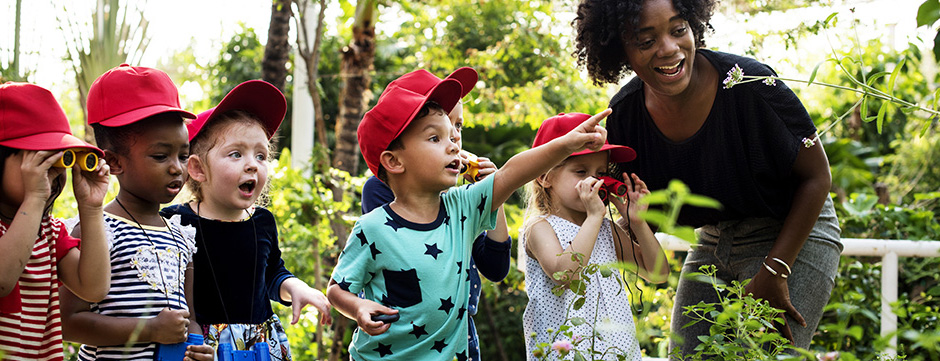Climate change has become a near constant topic of discussion, whether on the news, around the dinner table, or among friends, and anxious feelings are stemming from the state of the environment. There’s even a name for those feelings; Eco-Anxiety.
As a parent, you may have experienced Eco-Anxiety, and for some children who may pick up on the worries of those around them, threats to the environment are also on their minds. A 2019 Washington Post-Kaiser Family Foundation poll found that 57% of American teenagers said that climate change made them feel scared.
As with any kind of anxiety, if you think or suspect that your child is very worried about the environment or the future, you’ll want to talk to them about their fears in age-appropriate ways. Consider your own anxieties around climate change, and how you can be truthful while also remaining hopeful. Together as a family you can engage in some practical—and fun!—ways for kids and families to feel more empowered about aiding the planet.
Support Local Pollinators
Small pollinating animals, like bees, birds, butterflies, and more, are necessary for a healthy ecosystem and for plants to grow. You can help our pollinators do their job by providing them with flowers, plants, food, or water. Grow a few plants or a habitat garden, put up a bird feeder, or keep water in a birdbath to nourish birds. In supporting local animals, you’ll also learn a lot about the biodiversity in your area. Try these tips to make gardening fun for young children.
Plant or Befriend a Tree
In addition to their beauty, trees provide the oxygen we breathe, while absorbing pollutants. They help with climate, water run-off, and animal habitat. Here are some tips on how to plant a tree. No space? Organize a tree planting in your neighborhood or school. Your local public works department or non-profit can help with logistics. Or befriend a favorite tree and visit it through the seasons to learn more about it. As corny as it sounds, there really is something to hugging a tree and thanking it for the air we breathe.
Join or Organize a Cleanup of a Local Area
Many local Parks and Recreation departments, school and scout groups, and others sponsor cleanups in parks, on shorelines, and in other outdoor areas. If not, why not organize your own? The Better Beach Alliance offers resources to help you join a beach cleanup. Creating your own? These steps will help you plan and carry out a successful community cleanup.
Cut Down on Disposable Plastic
Much of the world’s pollution is caused by the creation and transportation of plastic. Plastic bottles in the landfill take centuries to decompose and many end up in our oceans and land. Learn and share these facts about disposable plastic and try to do your part to choose alternate materials and reuse and recycle your plastic.
Upcycle Your Clothing
“Fast fashion” is the name given to clothing practices that adversely impact the environment. Reduce your contribution to fast fashion by altering your own or someone else’s clothes to create a new garment. Have fun embellishing existing clothes, or make something completely new, using some of these upcycling ideas.
Change One Thing
Small changes can lead to bigger ones and help you feel better about your contributions in the world. Try to turn off faucets and lights when you’re not using them. Reuse containers and utensils for lunch. Bike or walk to school sometimes, if you can. Try to buy items locally and use your own bag.
Research a Charity and Raise Money for It
Support one of the many existing environmental charities by raising awareness and funds. You could sell baked goods or other handmade items to raise money for your charity. (Be sure to research local permit rules.) Make a flyer or give out a web site to provide information about the charity. This site can help you research non-profits by geographic area and area of concern. Look for organizations that have high ratings and accreditations. Charity Navigator can help you learn about top national and international non-profits, but you might want to contribute to something closer to home. Either way, be sure to do your homework before committing to help a charity.
Become a Citizen Scientist
Citizen scientists are everyday people of all ages who help researchers and others who are working to make a difference on environmental issues. Help track the cycle of plants throughout the year with Project BudBurst, to provide scientists with information about climate change. Or become an Otter Spotter and help record river otters (important indicators of healthy watersheds) for the River Otter Ecology Project. You can help count birds, bugs, meteors or squirrels. Find more Citizen Science ideas, along with these projects for year-round outdoor observation.
Spend Time in Nature
There’s no better way to increase your appreciation of nature than by getting out and enjoying it. People who spend time in nature create a relationship with plants and animals, so that the environment is no longer an abstract idea, and is instead something worth joyfully helping. Take a picnic to a park or go for a walk and see how many different colors of flowers you can find. Have fun experiencing nature in your own area. Try these tips for easing reluctant children outdoors.
Susan Sachs Lipman (Suz) is the author of Fed Up with Frenzy: Slow Parenting in a Fast-Moving World, which contains 300+ activities for family fun and grew out of her blog, Slow Family Online. Slow Parenting and the book were named a 2012 Top 10 Parenting Trend by TIME Magazine. Suz has written for the New York Times’ Motherlode blog, the Christian Science Monitor’s Modern Parenthood blog, and many others. She is a consultant for the Center for Children and Youth.



